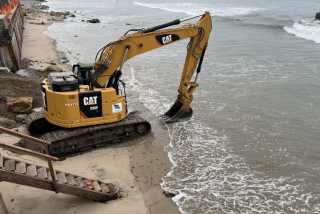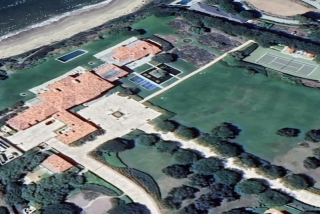The Malibu Beach Inn’s renovation leaves room for improvement
The fires that swept through Malibu last month may be the last time the middle classes get to stay at the colony’s newest luxury lodging.
The Malibu Beach Inn reopened Oct. 15 after a $10-million renovation. A week later, as fires raged through the area, the 47-room ocean-view hotel became a kind of deluxe command center that also offered lodgings free to firefighters and evacuees.
With published rates starting at $375 a night and averaging $600, and dinner for four in this guests-only restaurant easily reaching $400, the inn isn’t some surfer dude’s crash pad.
Owner David Geffen bought the hotel for a reported $29 million in 2005 and remade it into a place suitable for those aspiring to his tax bracket. Locals and outsiders alike have grumbled that it’s another land grab by the über rich, the only people who can afford to buy beach property these days.
But Geffen’s investment is tiny compared to that of software magnate Larry Ellison. Four years ago, Ellison spent $65 million on Malibu real estate and owns the now-vacant commercial lots near Geffen’s inn.
Gentrification aside, the inn (you can’t really call it a hotel) is a mellow getaway, a place to do little more than stare at the water and walk the beach -- and precisely because of that, it’s brilliant, if imperfect.
As soon as the fires were doused, I booked a two-night stay the first weekend in November through the inn’s website. The ocean-front queen room was listed at $385 a night, an introductory rate. For that, I got a 480-square-foot, second-floor room whose front door faced a hallway open to Pacific Coast Highway and a patio open to the Pacific Ocean. It’s a setup with heaven at the back door, hell at the front.
The attention to some aspects of service and clever design, however, aims to erase that nasty little highway with such things as wood-slat hallway partitions and uniformed valet attendants who radio the front desk that you’ve arrived. The 4 p.m. check-in means guests can settle into their rooms while it’s daylight, an excellent time to be seduced by the view. When the bellman opens the room door, all you see is the great, glittering ocean, framed by your 12-foot-wide room.
I had expected a luxury floor plan, not something that seemed like a dressed-up motel room, as this one did. The desk, gas fireplace, coffee table and 7-foot-long sofa sleeper hug the walls, but from the bed, you can look straight out at the water and sky.
The tidy bathroom includes a single sink with ample counter space, a lighted makeup mirror, Molton Brown toiletries and a limestone-tiled shower in place of a bathtub. My new favorite amenity? Two sets of robes, one waffle-weave cotton, the other silky, dry-clean-only Trink Turk print kimonos.
The décor’s tweedy textures and menswear tones deliver the comfortable, casual feel of a guy’s favorite sweater -- merino, not cashmere. The furniture doesn’t say “deluxe” partly because it looks like what you might find in discount stores. The bed is queen in name, but it was only 5 inches wider than my double at home.
And, honey, can we talk sheets? The press materials promise 400-thread-count luxury linens, but this princess sensed a pea, so I read the sheets’ fabric content tags -- a not-quite-silky 310-count polyester-cotton blend.
Book this room on a winter weekend and you may pay $530 a night.
My hopes for a stellar stay were stoked by a pre-visit e-mail that the inn sent, asking my preferences in wines, linens, music and more. I dutifully replied and, upon arrival, found my room stocked with a complimentary bottle of Saddlerock Pinot, appropriate Riedel stemware and six extra bath towels. (The general manager, Alan Goldschneider, swore he didn’t know I was visiting; his strategy is to customize each visit.)
That was one of the few times that service matched my luxury expectations. The just-born hotel had a string of technical difficulties on my stay: The fireplace pilot light was out, the in-room safe had no instructions and a stuck door; the 32-inch plasma TV couldn’t always access the cable channels; the phone’s programmed buttons and the iPod player didn’t work. But most of these problems were remedied nearly instantly when I called attention to them, though I soon gave up calling for more repairs.
As for the restaurant, it needs work. A lot. My litany of complaints includes slow service, cold coffee, gargantuan plates and wine buckets without stands that further crowd the compact tables.
The staff is only vaguely familiar with the menu and the protocol of fine service. A dinner for four of two appetizers, four entrees, one bottle of wine, one cup of coffee and one dessert was $393. I was still hungry afterward, so I raided my room’s Dean & Deluca mini-bar ($7 for smokehouse almonds). At least there was no additional mini bar restocking fee.
I had hoped to feel at every moment that I was at the beach, or at least to absorb the mystique that is Malibu, maybe even spot that Malibu mascot: the unhinged celebrity. Yet the design by Culver City’s dbaArchitects Inc. does little to bring the outdoors in, though the design maximizes the property’s best assets: the view and steps-from-the-sand location.
The layout is also sensitive to intangibles such as privacy from balconies built to block the neighbors. (Too bad its 16-inch-square stool can’t double as a dining table.)
Of course, with the curtains and patio door open, the guest room is a full-on ocean experience. At night with the curtains closed, the room could as easily be in Chicago as Malibu. A glass jar stuffed with seashells is an underwhelming nod to the sea. The photorealistic prints by Glenn Ness are intriguing but not uplifting: They picture a lonesome motel pool draped in foreboding shadows.
The room’s exacting temperature controls and nicely high-tech lighting, including dimmers and inset spotlights, make it easy to hang out indoors for a long while. Given a rainy day, I’d love a chance to sip through the mini bar’s impressive selection of California wines.
Though the beach is gaga gorgeous, in November it’s not much used. The now-smaller outdoor hotel patio seats diners and drinkers who can withstand the heater-free space. I saw only two Saturday morning fishermen taking advantage of the waters and its sofa-sized boulders.
Legally, most of the beach outside of the inn is public space. Still, the inn offers $75 daily and nearly $6,000 annual memberships to its Carbon Beach Club. Members can get customized beach baskets filled with preferred drinks and sunblock, for example, and access to lounge chairs and shower cabanas.
There are now several points of public access to this stretch of sand, yet I encountered only one soul on my eastbound walk, which included a peek at Geffen’s Cape Cod-style compound.
Walk west and you can end up at the historic Adamson House, a beach-home monument to Malibu Potteries and the family that fought for decades to keep Malibu private.
Drive up PCH toward Pepperdine University and you see more evidence of the recent wildfires. Co-existing with nature has always been fraught with hazard in Malibu. Now some of us will risk that other daring feat: visiting where billionaires sleep.
valli.herman@latimes.com
More to Read
Sign up for The Wild
We’ll help you find the best places to hike, bike and run, as well as the perfect silent spots for meditation and yoga.
You may occasionally receive promotional content from the Los Angeles Times.






